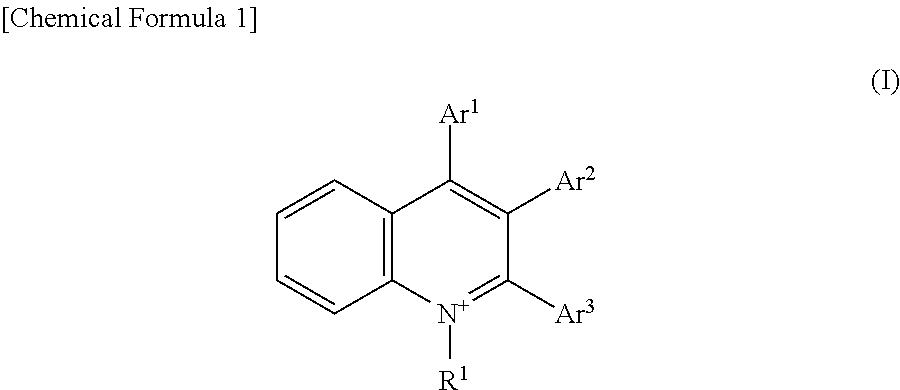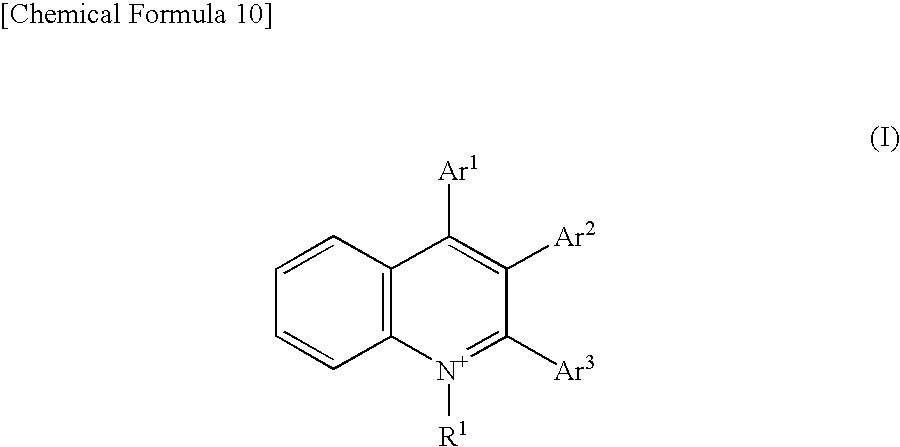Quinolinium ion derivatives, process for the production of the derivatives, products made by using the same, and reduction and oxidation methods with the derivatives
a technology of quinolinium ion and derivatives, applied in the field of quinolinium ion derivatives, can solve the problem of not having sufficient reducing power of electron donor-acceptor dyad, and achieve the effect of high oxidizing power and high reducing power
- Summary
- Abstract
- Description
- Claims
- Application Information
AI Technical Summary
Benefits of technology
Problems solved by technology
Method used
Image
Examples
examples
[0091]Next, examples of the present invention are described but the present invention is not limited to the following examples. The theoretical speculations about, for example, reaction mechanisms described in the following examples merely indicate examples of, for instance, presumable mechanisms and do not limit the present invention by any means.
[0092]In the following examples, the nuclear magnetic resonance (NMR) spectrum was measured using an apparatus, JNM-AL300 NMR spectrometer (trade name) (300 MHz for 1H measurement), manufactured by JEOL Ltd. The chemical shift is indicated in parts per million (ppm). Tetramethylsilane (TMS) was used for the internal standard, 0 ppm. The coupling constant (J) is indicated in hertz, and the brevity codes s, d, t, q, m and br indicate singlet, doublet, triplet, quartet, multiplet, and broad, respectively. The mass spectrometry (MS) was measured by the MALDI-TOF-MS method using an apparatus, Kratos Compact MALDI I (trade name), manufactured by...
examples 1 to 5
[0093]As described below, salts of quinolinium ion derivatives represented by the aforementioned formulae 1 to 5 were synthesized (Examples 1 to 5, respectively), and the properties such as the oxidation-reduction potential and generation of a charge-separated state through photoexcitation were checked.
[1] Synthesis of Quinolinium Ion Derivatives 1 to 5
[0094]Salts of the quinolinium derivatives represented by the aforementioned formulae 1 to 5 were synthesized. The aforementioned formulae 1 to 5 will be indicated below once again.
[0095]
[1-1] Synthesis of Quinolinium Ion Derivatives 1 to 3 (Examples 1 to 3)
[0096]Perchlorate of quinolinium ion derivative 2 (3-(1-naphthyl)quinolinium ion) was synthesized according to the following scheme 1.
[0097]
[0098]Hereinafter, the above-mentioned scheme 1 is described in further detail.
[0099]Before the reaction of the above-mentioned scheme 1 was performed, 1-naphthylboronic acid ester (2-1) was synthesized first. That is, first, a Grignard reagent...
example 6
Reductant and Reduction Method
[0132]The quinolinium ion derivatives 1 to 5 synthesized in Examples 1 to 5 each were subjected to an electron transfer reaction (reduction reaction) from the electron-transfer state (charge-separated state) to the electron acceptor molecule, and thereby the reducing ability of the electron-transfer state (charge-separated state) was checked. The electron acceptor molecule (substance to be reduced) used herein was hexylviologen.
[0133]The electron transfer reaction (reduction reaction) is described below in further detail. That is, first, both the hexylviologen and perchlorate of the 2-phenyl-4-(1-naphthyl)quinolinium ion (quinolinium ion derivative 5) synthesized in Example 5 described above were dissolved in deoxygenated acetonitrile and thereby a mixed solution of 2-phenyl-4-(1-naphthyl)quinolinium ion and hexylviologen was obtained. The concentration of this mixed solution was set so that the 2-phenyl-4-(1-naphthyl)quinolinium ion concentration was 0...
PUM
| Property | Measurement | Unit |
|---|---|---|
| carbon number | aaaaa | aaaaa |
| carbon number | aaaaa | aaaaa |
| temperature | aaaaa | aaaaa |
Abstract
Description
Claims
Application Information
 Login to View More
Login to View More - R&D
- Intellectual Property
- Life Sciences
- Materials
- Tech Scout
- Unparalleled Data Quality
- Higher Quality Content
- 60% Fewer Hallucinations
Browse by: Latest US Patents, China's latest patents, Technical Efficacy Thesaurus, Application Domain, Technology Topic, Popular Technical Reports.
© 2025 PatSnap. All rights reserved.Legal|Privacy policy|Modern Slavery Act Transparency Statement|Sitemap|About US| Contact US: help@patsnap.com



